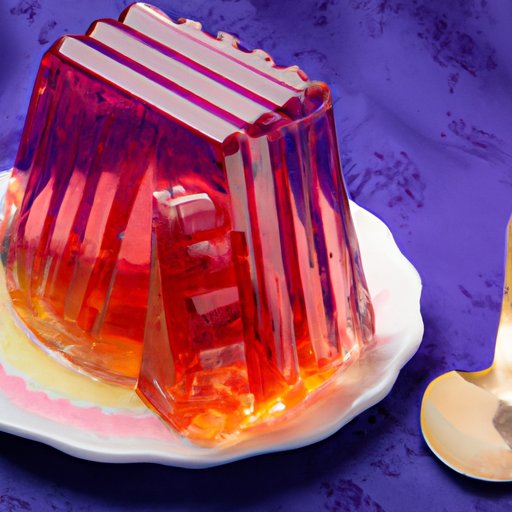I. Introduction
When it comes to quick and easy desserts, jello is a classic. Whether you’re making it for a summer barbeque or a potluck with friends, jello is a versatile and crowd-pleasing treat. But have you ever wondered how to make jello from scratch? In this article, we’ll break down the process step-by-step and offer tips for achieving the perfect texture and flavor. Beyond that, we’ll explore creative ways to use jello in salads or even as a hair product! We’ll also discuss nutritional benefits and potential drawbacks. Finally, we’ll delve into the history and cultural significance of this beloved dessert.
II. Step-by-Step Guide to Making Jello
The first step in making jello is to gather your ingredients – a box of jello mix, boiling water, and cold water. Once you have everything on hand, follow these steps carefully:
- Boil one cup of water in a saucepan or kettle.
- Empty the contents of the jello packet into a large mixing bowl and add the boiling water.
- Stir for two minutes or until the jello mix is completely dissolved.
- Add one cup of cold water to the mixture and continue stirring.
- Pour the mixture into a glass dish or individual molds of your choice and refrigerate for at least 4 hours or until firm.
While the classic method is simple, there are some tips and tricks for getting the best results. For example, if you like a firmer jello, you can increase the amount of gelatin in the recipe. If you prefer a softer, more delicate texture, you can decrease the amount. You can also experiment with different flavors (cherry, lime, and orange are some popular options) or even mix in fresh fruit or whipped cream for added texture and flavor.
III. Creative Ways to Use Jello Beyond Dessert
Jello is a versatile ingredient that can be used in many different ways beyond just dessert. Here are a few creative ideas:
- Jello shots – for a boozy twist on this classic dessert, try making jello shots. Simply substitute some of the cold water for alcohol and follow the recipe as usual.
- Jello fruit salad – mix chopped fresh fruit with jello for a delicious and colorful side dish.
- Jello aspic – a savory version of jello that’s popular in some parts of the world. You can mix in meat or vegetables for added texture and flavor.
But beyond these more common uses, some people have used jello in even more creative ways. For example, some beauty bloggers have experimented with using jello as a DIY hair mask, with mixed results. And some artists have even used jello in their sculptures and installations!
IV. The Nutritional Benefits and Potential Drawbacks of Consuming Jello
While jello is generally seen as a fun and harmless treat, there are some important things to keep in mind when it comes to nutrition. On the plus side, jello is a low-calorie, low-fat snack that can be a good source of hydration. It’s also a good source of collagen, which can benefit your skin, hair, and nails. However, some concerns have been raised about the use of artificial sweeteners and food dyes in jello. Additionally, some people may be sensitive to the sulfites in gelatin, which can cause allergic reactions in some cases.
If you’re concerned about the potential drawbacks of consuming jello, there are some alternatives to consider. For example, you can make your own jello using fresh fruit juice instead of the prepackaged mix. Or, you can experiment with other natural gelling agents like agar-agar, which is made from seaweed and is naturally high in fiber and antioxidants.
V. The History of Jello and Its Cultural Significance in North America
Believe it or not, jello has a rich and fascinating history that dates back to the 1800s. The basic recipe for jello – mixing boiling water with gelatin – was originally developed in France as a way to preserve food. Over time, the recipe spread to other parts of the world and eventually became associated primarily with desserts.
In the United States, jello became especially popular in the mid-1900s, thanks in part to a massive marketing campaign by the company that still produces it today. The bright colors and jiggly texture of jello quickly captured the imaginations of Americans across the country, and it became an iconic dessert that was often served at family gatherings and potlucks.
VI. The Science Behind Making Jello
While jello might seem like a simple dessert, there’s actually a lot of science behind the process of making it. Gelatin, which is the key ingredient in jello, is a protein that can form a gel when cooled. The process of making jello involves dissolving the gelatin in hot water, which allows the individual protein molecules to spread out and form a more stable structure. When the mixture is then cooled, the protein molecules come back together, resulting in the familiar semi-solid texture of jello.
VII. Conclusion
In conclusion, jello is a fun and versatile dessert that can be enjoyed in many different ways. With a little bit of know-how, it’s easy to make your own jello from scratch and experiment with different flavors and mix-ins. However, it’s also important to be aware of potential concerns around nutrition and to choose natural, healthy ingredients whenever possible.
